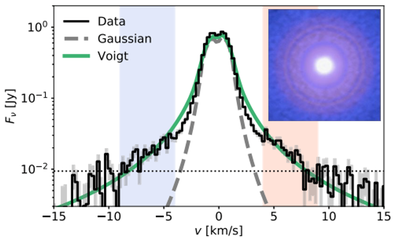New Method for Measuring Gas Surface Density in a Planet-Forming Disk
|
Fig: ntegrated spectrum of CO (3-2) in the 0.2" aperture centered at the stellar position. The inset shows the dust continuum image and the central white area roughly corresponds to the location where enough amount of gas to form a Jupiter-mass planet is present, as estimated in this study. |
The evolution of gas surface density in protoplanetary disks is one of the very basic properties to understanding the process of planetary-system formation. However, molecular hydrogen, which accounts for most of the gas mass, does not emit efficiently at low temperatures, and the conversion of CO to H2, as well as the conversion from the dust to gas mass, is known to be highly uncertain. Accurate measurement of the gas surface density has therefore remained a challenge for a long time. In the recent ALMA study, the graduate student Tomohiro Yoshida and his colleagues have analyzed the CO line profiles for the disk around TW Hya with a sensitivity more than 10 times higher than previously used, and found the pressure broadening of the spectral line at the center of the disk. The gas surface density estimated from the pressure broadened line wings suggests that the inner region (inside ~5 au) has sufficient mass to form a Jupiter-mass planet. The pressure broadening in CO could provide a new way to directly measure the gas surface density in protoplanetary disks without an assumption of CO/H2. |

